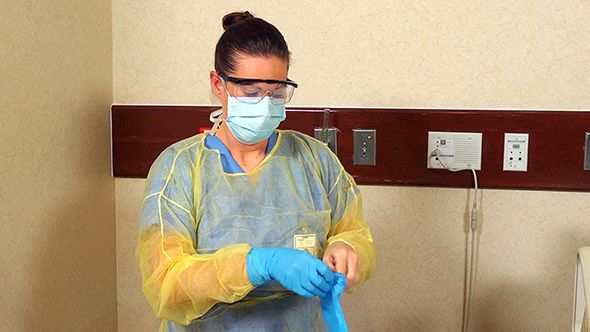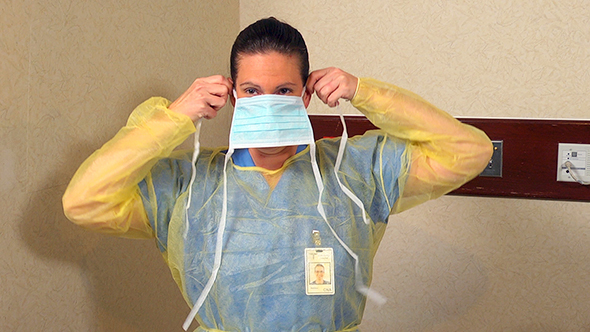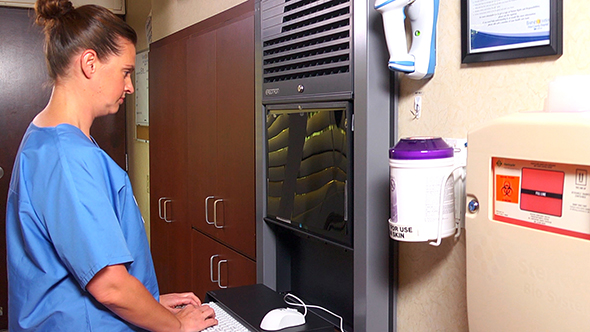Infection Control and Safety Measures
Select a Skill:
- » Performing Hand Hygiene
- » Using Personal Protective Equipment
- » Using Restraint Alternatives
- » Applying Restraints Safely
Take the Review Test:

Purpose

- As part of Standard Precautions, personal protective equipment (PPE) reduces the risk of spreading infection.
- PPE includes gloves, gowns, masks, respirators, goggles, and face shields.
- Gloves act as a barrier. They protect you from pathogens in the person’s blood, body fluids, secretions, and excretions. They also protect the person from microbes on your hands.
- Gowns prevent the spread of microbes. They protect your clothes and body from contact with blood, body fluids, secretions, and excretions. They also protect against splashes and sprays.
- Masks and respirators offer protection from contact with the person’s infectious material, such as respiratory secretions and sprays of blood or body fluids. During sterile procedures, they protect the person from infectious agents carried in your mouth or nose.
- Goggles and face shields protect your eyes, mouth, and nose from splashing and spraying of blood, body fluids, secretions, and excretions. Splashes and sprays can occur when you give care, clean items, or dispose of fluids.
Equipment
Roll cursor over items to see labels. For the purposes of clearly depicting the equipment, a barrier is not shown in this photo. When providing care, a barrier should always be placed on the surface before placing the equipment.

Face shield
Mask
Gown
Respirator
Goggles
Gloves
Delegation

- Check with the nurse and care plan about:
- What PPE to use.
- What special safety measures are needed.
Preparation

- Review the information under Safety and Comfort.
- Plan to wear gloves when contact with blood, potentially infectious materials, mucous membranes, non-intact skin, or contaminated skin is likely.
- Plan to wear a gown to protect your skin and clothing when contact with blood, body fluids, secretions, or excretions is likely. Also wear a gown for direct contact with a person who has uncontained excretions or excretions. Always wear gloves when a gown must be worn.
- Plan to wear a mask and goggles or a face shield for procedures and tasks that are likely to cause splashes and sprays of blood, body fluids, secretions, or excretions.
- Plan to don PPE in this order:
- Gown
- Mask or respirator
- Goggles or face shield
- Gloves
- Plan to remove PPE in this order:
- Gloves
- Goggles or face shield
- Gown
- Mask or respirator
Safety

- Always follow the correct procedure for removing gloves. No special method is needed to put on non-sterile gloves.
- Stay alert for signs of an allergy to latex (a rubber product in some gloves), such as skin rashes, asthma, and shock. Report skin rashes and breathing problems to the nurse at once.
- Check the person’s care plan and your assignment sheet for a note about a latex allergy. Wear latex-free gloves when caring for a person with a latex allergy.
- Even if you wear eyeglasses, use a face shield that fits over your glasses with minimal gaps. Regular eyeglasses and contact lenses do not protect you from splashing.
- Be aware that goggles do not provide splash or spray protection to other parts of your face.
Comfort
- To reduce exposure to latex, wear gloves only when needed. Gloves are needed whenever contact with blood body fluids, secretions, excretions, mucous membranes, or non-intact skin is likely. Gloves are not needed when such contact is not likely, such as when giving a back massage and brushing hair.
Procedure Video
Audio Description: OFFFollow-up Care
- This skill does not include follow-up care content.
Reporting/Recording
- This skill does not include reporting and recording content.
Review Questions
Select the best answer.
1. What is the purpose of wearing a face shield when providing patient care?
 To protect your skin from contact with infection
To protect your skin from contact with infection To protect your eyes from being splashed with hazardous chemicals
To protect your eyes from being splashed with hazardous chemicals To protect your clothes and body from contact with pathogens
To protect your clothes and body from contact with pathogens To protect your eyes, mouth, and nose from being infected through splashing
To protect your eyes, mouth, and nose from being infected through splashing
Select the best answer.
2. Which sign or symptom may suggest an allergy to latex gloves?
Select the best answer.
3. What is the correct order for putting on personal protective equipment (PPE)?
 Gown, mask, goggles, gloves
Gown, mask, goggles, gloves Gown, mask, gloves, goggles
Gown, mask, gloves, goggles Mask, goggles, gloves, mask
Mask, goggles, gloves, mask Gloves, gown, mask goggles
Gloves, gown, mask goggles
Select the best answer.
4. When removing a gown, which technique should you use?
 Turn the gown inside out as you remove it
Turn the gown inside out as you remove it Roll the gown down against your body
Roll the gown down against your body Let the gown fall to the floor without touching it
Let the gown fall to the floor without touching it Touch only the outside of the gown
Touch only the outside of the gown
Select the best answer.
5. Immediately after removing PPE, what should you do?
 Notify the charge nurse that you have completed patient care
Notify the charge nurse that you have completed patient care Document the care that was given
Document the care that was given Perform hand hygiene
Perform hand hygiene Disinfect the reusable equipment
Disinfect the reusable equipment
You have completed the Review Questions for this skill. To take the Review again select the Start Over button. To proceed to another skill select from the dropdown menu. Select the Home or Back button to proceed to the next section.

